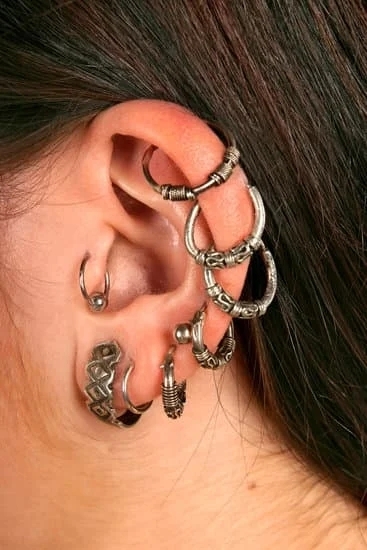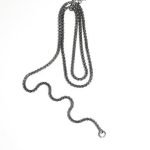When it comes to fine jewelry, many people take time to consider what kind of metal or stone they want in their piece but forget about the possibility that their jewelry will eventually become tarnished. Tarnishing is a common problem when it comes to rings, necklaces and other pieces of jewelry, and it often happens as a result of sunlight, humidity, perspiration and chemicals in the air.
As such, it can be hard for your beautiful piece of jewelry to last for more than a few months before it begins to look dull and outdated. Fortunately, there are some materials available that do not require polishing and will not develop tarnish over time.
One of the best jewelry materials that does not tarnish is stainless steel. This material is highly durable with scratches only rarely appearing after a long period of usage and wear.
Stainless steel also has strong anti-corrosive properties which makes it ideal for individuals looking for longevity in their jewelry pieces. In addition, stainless steel isn’t as expensive as some metals used in higher-end jewelry like gold so you get good value without having to worry about its longevity.
Titanium is another popular choice among many fashion-conscious individuals because of its durability and lack of pronged breakage like silver or gold jewellery does when subjected to regular wear and tear conditions over time.
Titanium is renowned for its scratch resistance, light weight feel yet strong structure making it ideal for jewellery pieces such as bracelets , earrings or necklaces that are worn on a regular basis requiring light maintenance from time to time so as not compromising its aesthetic finish.
It also benefits from having a silvery color which imparts an elegant glow onto any design making titanium pieces stand out anytime.
In conclusion, finding the right material for your fine piece doesn’t have to be complicated or expensive if you know what options are available such as stainless steel and titanium which don’t require much care and won’t become tarnished with age. Not only do these metals excel in terms of durability but they also offer tremendous value while keeping your jewelry looking great all year round without any extra effort.
Explanation of What Tarnishing Is
Tarnishing is a type of corrosion that visibly impacts the surface of certain metals. It occurs when the metal and air (or other liquid or gas) come into contact with each other, resulting in the oxidation of the metal molecules on the object’s surface.
This eventually results in a discolored, patchy appearance of greyish white on jewelry pieces made from silver, copper, or other alloy materials. Tarnishing can occur over time if a piece is not kept stored in a low-humidity environment such as an anti-tarnish jewellery box, for example.
Jewelry Material That Does Not Tarnish – Exploring alternative metal jewelry materials and their benefits
Good news for metal jewelry lovers. What tarnishes some metals such as silver and copper don’t necessarily affect all others. One popular choice of material among fashionistas seeking long-lasting pieces is sterling silver which rarely tarnishes but requires regular maintenance to keep its luster.
Some alternatives to sterling silver include stainless steel which won’t corrode due to marine environment or perspiration and titanium which is light weight and hypoallergenic but not explicitly solid (i.e., prone to being scratched). Stainless steel jewelry also has the added benefit of being more affordable than its precious metal counterparts.
Jewelry That Doesn’t Need Regular Maintenance – Discussing further advantages associated with these alternative materials
Not only are these non-precious metals more accessible from a financial standpoint but they also require less maintenance than their traditionally valuable counterparts – no annual polishing sessions necessary. As mentioned earlier, stainless steel’s resistance to corrosion makes it ideal for those frequent swimmers or simply those who prefer durable pieces which can be worn everyday without fear that it will become discoloured over time from contact with sweat/water/ chemicals found in perfumes etc.
Titanium jewelry is also scratch resistant and more lightweight than most metals making it another viable option for those seeking unique accessory pieces for special occasions plus everyday wearability without fear of damage occurring over time.
Types of Jewelry Metals
Gold is an incredibly popular choice for jewelry, and it is particularly desirable because of its bright yellow color and resistance to rusting or tarnishing. Gold jewelry can be alloyed with other metals to change its characteristics, making it stronger, less brittle and often more affordable.
White gold is created by alloying yellow gold with silver or nickel; the color resulting from this combination can range from a bright white to grayish-white depending on the alloys used. Some examples of gold jewelry include earrings, necklaces, bracelets, charms and rings.
Silver is one of the oldest metals used for crafting jewelry. It usually appears in its purest form as white sterling silver that rarely requires polishing to keep its shine. Silver tarnishes easily compared to other precious metals such as gold or platinum because it is so soft and porous. Pure silver (999) should not contain any impurities although some may be added for strength during processing. Common pieces made from this metal are bracelets, earrings, necklaces and rings.
Platinum is also popularly used in jewelry manufacturing due to its purity (typically platinum will only have between 85-95% actual platinum content), rarity and resistance to heat damage, oxidation or tarnish. Platinum tends to be a very malleable metal that also helps make intricate designs easier than with other metals such as silver or gold.
Platinum is also hypoallergenic so those who have skin sensitivity issues can enjoy wearing jewelry crafted from this material without fear of irritation or rashes developing due to contact with their skin. In addition, a wide variety of necklaces, rings , bracelets and glasses frames can be made using this metal.
Other rarer materials which do not naturally tarnish are titanium long considered an exotic metal due increasingly popular choice amongst modern generations due in part to beautiful but signature grey sheen which provides low key understated look yet impressive durability. The high strength characteristics make it perfect for renowned engineering applications plus lighter weight appeal fashion jewellery like watches bands hoops etc.
Durability does not just come in the form of resisting tarnisring though ; titanium has grade one scratch resistance equal even precious stone varieties.Finally palladium another rarely seen though similar properties as platinum including white colour malleability yet perhaps its greatest claim fame ability remove odours via chemical process known catalysis where traditional materials cannot produce same outcome.
What Jewelry Does Not Tarnish
When considering jewelry, the appearance needs to last as long and look as good as the day you purchased it. You want something that won’t tarnish or change color over time. That’s why knowing which materials will give you the longest lasting shine is important when searching for jewelry pieces.
One of the most popular materials that don’t tarnish is titanium. Titanium is a durable metal, which makes it an ideal choice for jewelry since it resists scratching and discoloration. It comes in different colors so it can be used to create customized looks. Additionally, titanium requires little maintenance compared to other metals, so it makes a great choice for those wanting reliable and lasting shine on their jewelry pieces.
Gold plated and gold filled jewelry are also great choices that don’t tarnish easily over time. Gold plated items consist of a base metal being covered with a layer of solid gold on top – this makes the item more resistant to tarnishing due to its protective layer of gold-.
While gold-filled jewelry has similar qualities as those described above, but instead of a protective coating, this type mixes gold into its base metal during the production process that creates much stronger piece than one with only plating.
Another option similar to gold filled Jewelry is silver-filled items which typically consist of layers of sterling silver being electroplated to offer more protection against tarnishing for a longer duration compared to silver plated pieces that require more regular cleaning and polishing in order maintain their luster and shine.
The last material that does not normally tarnish are gemstones such as diamonds, rubies, sapphires and more; these come from natural formations without any human alteration which make them resistant to tarnishment or fading in color. As beautiful adornments they offer a unique aspect for each type making them perfect for creating elegant pieces like rings, necklaces or earrings with little worry about wear and tear damage.
Protecting Jewelry from Tarnishing
Jewelry is a great way to express our personal style and individuality. It is an accessory that can really make a statement, however it needs to be cared for. Most jewelry materials are prone to tarnishing over time due to environmental factors or improper care. Even if your jewelry is made of a material that does not tarnish, you still need proper care and maintenance in order to keep it looking brand new.
The most common metals used in jewelry-making such as silver, gold, and copper are known to tarnish eventually. Some materials do exist that do not tarnish when exposed to the environment such as stainless steel, tungsten carbide, cobalt chrome and titanium.
These materials are highly durable and resistant to corrosion which makes them ideal for making jewelry as they will retain their sheen even after long-term exposure to moisture and air. In addition, they are hypoallergenic, so they won’t cause any allergic reactions on the skin like some other metals might.
Even though these materials mentioned earlier don’t rust or corrode easily, there are still several steps that you should take in order to protect them from tarnishing over time – this includes limiting their exposure to water and cleaning them regularly with soft cloths or special polishes for metal surfaces.
Furthermore, proper storage of your jewelry is key – this means storing pieces in a dry area away from harsh chemicals or environments that could cause discoloration or damage the material of your jewelry over time.
To further extend the life of your accessories avoid wearing them during activities where they will have contact with chlorine, salt water or sweat because the salts and metals found in those environments can erode away at the stones found on your pieces over time.
Benefits of Jewelry That Does Not Tarnish
Jewelry made from materials that do not tarnish have many benefits to them. The main advantage is the exceptional wearability. As long as the piece of jewelry is properly taken care of, it can last a lifetime and even become an heirloom to be passed down through generations.
Unlike other metals that may need regular cleaning in order to retain their shine, metals such as gold, titanium, stainless steel and sterling silver will not oxidize or discolor when exposed to air or moisture. This means there’s less maintenance needed over time and makes these pieces great for everyday wear since you don’t have to continuously reapply polish and take special precautions when wearing them out of the house.
Another great benefit to having jewelry that does not tarnish is cost effectiveness. These metals are more resistant to corrosion than other forms of metal, meaning they won’t totally lose their shape or color over time.
That being said, you don’t have to constantly buy replacements for your favorite piece of jewelry like you would with cheaper options such as copper or brass. You get value for your money as well as a better looking piece of quality jewelry that will last much longer than other alternatives in the same price-range.
Lastly, these specific metals are incredibly versatile when it comes to constructing beautiful pieces of jewelry without losing any detail due to tarnishing or corrosion over time. The polished look associated with stainless steel, titanium and sterling silver never fades so there doesn’t need special attention when storing away these precious items either meaning there’s no reason why these pieces can’t be treasured for years on end by their owners.
In addition, each type has its own unique characteristics that make it suitable for different types of designs which helps make sure you find something perfect for you regardless of your preference which can sometimes be tricky when approaching buying traditional metal information pieces that tend to degrade faster than those crafted with material that doesn’t tarnish.
Shopping for Jewelry That Does Not Tarnish
When shopping for jewelry that won’t tarnish, it’s important to know what type of metals tend to resist tarnishing. Perhaps the most well-known metal that does not tarnish is gold. Gold jewelry alloyed with metal such as zinc or nickel can be extremely durable and its corrosion-resistant properties will ensure the piece looks good for a long time.
Platinum is another option you might want to consider. Known for its lustrous white color, it also has relatively low reactivity and therefore is highly resistant to corrosion and oxidization.
Other metals notably Cobalt Chrome and Titanium are much newer technologies used in the making of jewelry pieces and do not corrode at all due to their hypoallergenic qualities. These sturdy metals are resistant to scratches and blemishes, so you don’t need to worry about them losing their luster any time soon no matter how often you wear them.
If you prefer gemstones over metal, there are quite a few choices when buying jewelry that won’t tarnish. Some of the sturdiest options include rubies, diamonds, amethysts, quartz, turquoise, sapphires and jade.
As they aren’t made up of reactive elements like platinum or gold, they won’t suffer from oxidization and will keep their unique beauty year after year without needing any special care or maintenance. Of course these precious stones come with a higher price tag but if you invest in high quality pieces they should last you forever.
The best place to shop for high quality jewelry materials and items that won’t tarnish would definitely be locally owned jewelry stores or online boutiques which are more likely to carry authentic pieces rather than generic items available at big box stores. Also checking customer reviews can give insight into the store’s overall quality and customer service before making your purchase decision.
Alternatives to Non-Tarnishing Materials
Metal plating is a popular choice for jewelry makers who value non-tarnishing materials in their designs. It’s a great way to give jewelry pieces an extra touch of luxury without the commitmment of buying expensive materials or investing in specialist finishing processes. Plating is achieved by putting a thin layer of metal onto an otherwise ordinary material, such as brass or zinc.
This new layer adds shine and depth to any piece, but more importantly it prevents oxidation by protecting the base metal itself. This can be extremely beneficial in terms of preserving the ‘new’ look of the final product over its lifetime, avoiding unwanted patinas and discolouration.
Another option for crafting jewelry in non-tarnishing materials is laminate. Laminate uses multiple layers of paper to harden and protect the piece from water damage, scratches and fingerprints.
Not only are these laminates highly protective but they offer a sleek and low maintenance finish that won’t tarnish over time – making them perfect for any type of accessory like rings, necklaces or even watches. The durability offered by these laminates also means that should any dulling occur on the surface of the material due to regular wear and tear, you won’t need to worry about replacing it too soon.
Additionally, glazes are incredibly useful when looking to create pieces made out of high quality non-tarnishing materials that can last longer than other metals or alloys used in jewelrymaking. Glaze most commonly refers to coatings applied after firing pottery or ceramics; however glazes can also be used with metals as well as plastics used in manufacturing accessories.
Glaze works much like paint on surfaces; it seals out moisture preventing oxidation from taking hold which would normally lead to discolouration over time – meaning jewelry pieces stay intact with their original shade as long as you take care with them properly.
Conclusion
Jewelry made of materials that do not tarnish is a great choice for those seeking beautiful accessories that will last. Some jewelry material choices are more likely to tarnish over time than others, so it’s important to keep this in mind when selecting pieces.
Jewelry materials that won’t tarnish include gold and silver, stainless steel, tungsten carbide, titanium, rhodium plated sterling silver and even some plastic jewelry. Metal alloy-based items made with combinations of these materials can also be good choices as they tend to retain their color longer than pure metals.
The benefits of opting for jewelry made from materials that don’t tarnish are numerous. First, you don’t have to worry about polishing the piece continually, or having it look dull after too much wear and tear. Second, you won’t have blotchy spots on your skin if the piece rubs against it due to reaction with sweat or moisturizing lotion.
Third, when you buy jewelry fabricated out of non-corrosive metals like gold and silver they usually require only la perla batting Average maintenance in order to keep their sheen intact. Finally, there is no need to purchase special products designed to restore the luster of a piece; its color simply won’t fade over time like other items might.
Finding pieces made from non-corrosive materials is easier now than ever before thanks to the internet. Online marketplaces such as Etsy offer an impressive selection of handmade items constructed out of all kinds of materials – pendants, necklaces, rings and earrings included – so you can find something perfect for any occasion without leaving your house.
It’s also possible to look into brick-and-mortar stores for high quality pieces that resist corrosion; be sure to ask questions before making a purchase if possible so you know exactly what material the piece is composed of. Ultimately by researching different brands ahead of time and carefully considering each item prior to purchase one can rest assured that their new accessory will stay vibrant and intact despite its frequent use.

Welcome to my jewelry blog! My name is Sarah and I am the owner of this blog.
I love making jewelry and sharing my creations with others.
So whether you’re someone who loves wearing jewelry yourself or simply enjoys learning about it, be sure to check out my blog for insightful posts on everything related to this exciting topic!





